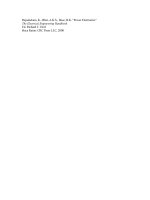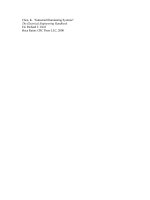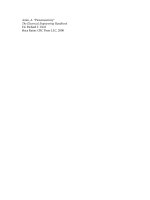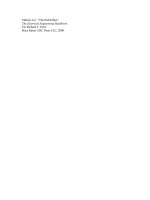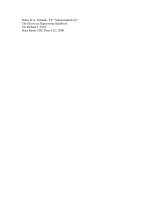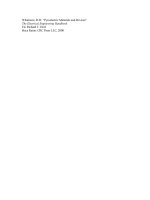Electrical engineering know it all
Bạn đang xem bản rút gọn của tài liệu. Xem và tải ngay bản đầy đủ của tài liệu tại đây (6.88 MB, 1,126 trang )
Electrical Engineering
Newnes Know It All Series
PIC Microcontrollers: Know It All
Lucio Di Jasio, Tim Wilmshurst, Dogan Ibrahim, John Morton, Martin Bates, Jack Smith, D.W. Smith, and
Chuck Hellebuyck
ISBN: 978-0-7506-8615-0
Embedded Software: Know It All
Jean Labrosse, Jack Ganssle, Tammy Noergaard, Robert Oshana, Colin Walls, Keith Curtis, Jason Andrews,
David J. Katz, Rick Gentile, Kamal Hyder, and Bob Perrin
ISBN: 978-0-7506-8583-2
Embedded Hardware: Know It All
Jack Ganssle, Tammy Noergaard, Fred Eady, Lewin Edwards, David J. Katz, Rick Gentile, Ken Arnold,
Kamal Hyder, and Bob Perrin
ISBN: 978-0-7506-8584-9
Wireless Networking: Know It All
Praphul Chandra, Daniel M. Dobkin, Alan Bensky, Ron Olexa, David Lide, and Farid Dowla
ISBN: 978-0-7506-8582-5
RF & Wireless Technologies: Know It All
Bruce Fette, Roberto Aiello, Praphul Chandra, Daniel Dobkin, Alan Bensky, Douglas Miron, David Lide,
Farid Dowla, and Ron Olexa
ISBN: 978-0-7506-8581-8
Electrical Engineering: Know It All
Clive Maxfi eld, Alan Bensky, John Bird, W. Bolton, Izzat Darwazeh, Walt Kester, M.A. Laughton, Andrew
Leven, Luis Moura, Ron Schmitt, Keith Sueker, Mike Tooley, DF Warne, Tim Williams
ISBN: 978-1-85617-528-9
Audio Engineering: Know It All
Douglas Self, Richard Brice, Don Davis, Ben Duncan, John Linsely Hood, Morgan Jones, Eugene Patronis,
Ian Sinclair, Andrew Singmin, John Watkinson
ISBN: 978-1-85617-526-5
Circuit Design: Know It All
Darren Ashby, Bonnie Baker, Stuart Ball, John Crowe, Barrie Hayes-Gill, Ian Grout, Ian Hickman, Walt
Kester, Ron Mancini, Robert A. Pease, Mike Tooley, Tim Williams, Peter Wilson, Bob Zeidman
ISBN: 978-1-85617-527-2
Test and Measurement: Know It All
Jon Wilson, Stuart Ball, GMS de Silva, Tony Fischer-Cripps, Dogan Ibrahim, Kevin James, Walt Kester,
M A Laughton, Chris Nadovich, Alex Porter, Edward Ramsden, Stephen Scheiber, Mike Tooley, D. F. Warne,
Tim Williams
ISBN: 978-1-85617-530-2
Mobile Wireless Security: Know It All
Praphul Chandra, Alan Bensky, Tony Bradley, Chris Hurley, Steve Rackley, John Rittinghouse, James
Ransome, Timothy Stapko, George Stefanek, Frank Thornton, Chris Lanthem, John Wilson
ISBN: 978-1-85617-529-6
For more information on these and other Newnes titles visit: www.newnespress.com
Electrical Engineering
Clive Maxfi eld
John Bird
M. A.Laughton
W. Bolton
Andrew Leven
Ron Schmitt
Keith Sueker
Tim Williams
Mike Tooley
Luis Moura
Izzat Darwazeh
Walt Kester
Alan Bensky
DF Warne
AMSTERDAM • BOSTON • HEIDELBERG • LONDON
NEW YORK • OXFORD • PARIS • SAN DIEGO
SAN FRANCISCO • SINGAPORE • SYDNEY • TOKYO
Newnes is an imprint of Elsevier
Newnes is an imprint of Elsevier
30 Corporate Drive, Suite 400, Burlington, MA 01803, USA
Linacre House, Jordan Hill, Oxford OX2 8DP, UK
Copyright © 2008, Elsevier Inc. All rights reserved.
No part of this publication may be reproduced, stored in a retrieval system, or transmitted in
any form or by any means, electronic, mechanical, photocopying, recording, or otherwise,
without the prior written permission of the publisher.
Permissions may be sought directly from Elsevier’s Science & Technology Rights
Department in Oxford, UK: phone: ( ϩ 44) 1865 843830, fax: ( ϩ 44) 1865 853333,
E-mail: You may also complete your request online
via the Elsevier homepage ( ), by selecting “ Support & Contact ”
then “ Copyright and Permission ” and then “ Obtaining Permissions. ”
Library of Congress Cataloging-in-Publication Data
Application submitted
British Library Cataloguing-in-Publication Data
A catalogue record for this book is available from the British Library.
ISBN: 978-1-85617-528-9
Typeset by Charon Tec Ltd., A Macmillan Company. (www.macmillansolutions.com)
Printed in the United States of America
08 09 10 10 9 8 7 6 5 4 3 2 1
For information on all Newnes publications
visit our Web site at www.elsevierdirect.com
Contents
About the Authors xv
Chapter 1: An Introduction to Electric Circuits 1
1.1 SI Units 1
1.2 Charge 2
1.3 Force 2
1.4 Work 3
1.5 Power 4
1.6 Electrical Potential and e.m.f. 5
1.7 Resistance and Conductance 5
1.8 Electrical Power and Energy 6
1.9 Summary of Terms, Units and Their Symbols 7
1.10 Standard Symbols for Electrical Components 8
1.11 Electric Current and Quantity of Electricity 8
1.12 Potential Difference and Resistance 10
1.13 Basic Electrical Measuring Instruments 11
1.14 Linear and Nonlinear Devices 11
1.15 Ohm’s Law 12
1.16 Multiples and Submultiples 13
1.17 Conductors and Insulators 16
1.18 Electrical Power and Energy 16
1.19 Main Effects of Electric Current 20
Chapter 2: Resistance and Resistivity 21
2.1 Resistance and Resistivity 21
2.2 Temperature Coeffi cient of Resistance 25
Chapter 3: Series and Parallel Networks 31
3.1 Series Circuits 31
3.2 Potential Divider 34
www.newnespress.com
vi Contents
www.newnespress.com
3.3 Parallel Networks 37
3.4 Current Division 43
3.5 Relative and Absolute Voltages 48
Chapter 4: Capacitors and Inductors 53
4.1 Introduction to Capacitors 53
4.2 Electrostatic Field 53
4.3 Electric Field Strength 55
4.4 Capacitance 56
4.5 Capacitors 56
4.6 Electric Flux Density 58
4.7 Permittivity 59
4.8 The Parallel Plate Capacitor 61
4.9 Capacitors Connected in Parallel and Series 64
4.10 Dielectric Strength 70
4.11 Energy Stored 71
4.12 Practical Types of Capacitors 72
4.13 Inductance 76
4.14 Inductors 78
4.15 Energy Stored 80
Chapter 5: DC Circuit Theory 81
5.1 Introduction 81
5.2 Kirchhoff’s Laws 81
5.3 The Superposition Theorem 89
5.4 General DC Circuit Theory 95
5.5 Thévenin’s Theorem 99
5.6 Constant-Current Source 106
5.7 Norton’s Theorem 107
5.8 Thévenin and Norton Equivalent Networks 111
5.9 Maximum Power Transfer Theorem 117
Chapter 6: Alternating Voltages and Currents 123
6.1 The AC Generator 123
6.2 Waveforms 124
Contents vii
www.newnespress.com
6.3 AC Values 126
6.4 The Equation of a Sinusoidal Waveform 133
6.5 Combination of Waveforms 139
6.6 Rectifi cation 146
Chapter 7: Complex Numbers 149
7.1 Introduction 149
7.2 Operations involving Cartesian Complex Numbers 152
7.3 Complex Equations 155
7.4 The polar Form of a Complex Number 157
7.5 Applying Complex Numbers to Series AC Circuits 158
7.6 Applying Complex Numbers to Parallel AC Circuits 171
Chapter 8: Transients and Laplace Transforms 185
8.1 Introduction 185
8.2 Response of R-C Series Circuit to a Step Input 185
8.3 Response of R-L Series Circuit to a Step Input 192
8.4 L-R-C Series Circuit Response 199
8.5 Introduction to Laplace Transforms 205
8.6 Inverse Laplace Transforms and the Solution of Differential Equations 215
Chapter 9: Frequency Domain Circuit Analysis 229
9.1 Introduction 229
9.2 Sinusoidal AC Electrical Analysis 229
9.3 Generalized Frequency Domain Analysis 257
References 315
Chapter 10: Digital Electronics 317
10.1 Semiconductors 317
10.2 Semiconductor Diodes 318
10.3 Bipolar Junction Transistors 319
10.4 Metal-oxide Semiconductor Field-effect Transistors 321
10.5 The transistor as a Switch 322
10.6 Gallium Arsenide Semiconductors 324
10.7 Light-emitting Diodes 324
10.8 BUF and NOT Functions 327
viii Contents
www.newnespress.com
10.9 AND, OR, and XOR Functions 329
10.10 NAND, NOR, and XNOR Functions 329
10.11 Not a Lot 331
10.12 Functions Versus Gates 332
10.13 NOT and BUF Gates 333
10.14 NAND and AND Gates 335
10.15 NOR and OR Gates 336
10.16 XNOR and XOR Gates 337
10.17 Pass-Transistor Logic 339
10.18 Combining a Single Variable With Logic 0 or Logic 1 342
10.19 The Idempotent Rules 342
10.20 The Complementary Rules 343
10.21 The Involution Rules 344
10.22 The Commutative Rules 344
10.23 The Associative Rules 344
10.24 Precedence of Operators 345
10.25 The First Distributive Rule 346
10.26 The Second Distributive Rule 346
10.27 The Simplifi cation Rules 348
10.28 DeMorgan Transformations 349
10.29 Minterms and Maxterms 351
10.30 Sum-of-Products and Product-of-sums 351
10.31 Canonical Forms 352
10.32 Karnaugh Maps 353
10.33 Minimization Using Karnaugh Maps 354
10.34 Grouping Minterms 355
10.35 Incompletely Specifi ed Functions 356
10.36 Populating Maps Using 0s versus 1s 359
10.37 Scalar Versus Vector Notation 360
10.38 Equality Comparators 361
10.39 Multiplexers 363
10.40 Decoders 364
10.41 Tri-State Functions 365
10.42 Combinational Versus Sequential Functions 367
10.43 RS Latches 367
Contents ix
www.newnespress.com
10.44 D-Type Latches 373
10.45 D-Type Flip-Flops 374
10.46 JK and T Flip-Flops 377
10.47 Shift Registers 378
10.48 Counters 381
10.49 Setup and Hold Times 383
10.50 Brick by Brick 384
10.51 State Diagrams 386
10.52 State Tables 387
10.53 State Machines 388
10.54 State Assignment 389
10.55 Don’t Care States, Unused States, and Latch-Up Conditions 392
Chapter 11: Analog Electronics 395
11.1 Operational Amplifi ers Defi ned 395
11.2 Symbols and Connections 395
11.3 Operational Amplifi er Parameters 397
11.4 Operational Amplifi er Characteristics 402
11.5 Operational Amplifi er Applications 403
11.6 Gain and Bandwidth 405
11.7 Inverting Amplifi er With Feedback 406
11.8 Operational Amplifi er Confi gurations 408
11.9 Operational Amplifi er Circuits 412
11.10 The Ideal Op-Amp 418
11.11 The Practical Op-Amp 420
11.12 Comparators 450
11.13 Voltage References 459
Chapter 12: Circuit Simulation 465
12.1 Types of Analysis 466
12.2 Netlists and Component Models 476
12.3 Logic Simulation 479
Chapter 13: Interfacing 481
13.1 Mixing Analog and Digital 481
13.2 Generating Digital Levels From Analog Inputs 484
x Contents
www.newnespress.com
13.3 Classic Data Interface Standards 487
13.4 High Performance Data Interface Standards 493
Chapter 14: Microcontrollers and Microprocessors 499
14.1 Microprocessor Systems 499
14.2 Single-Chip Microcomputers 499
14.3 Microcontrollers 500
14.4 PIC Microcontrollers 500
14.5 Programmed Logic Devices 500
14.6 Programmable Logic Controllers 501
14.7 Microprocessor Systems 501
14.8 Data Representation 503
14.9 Data Types 505
14.10 Data Storage 505
14.11 The Microprocessor 506
14.12 Microprocessor Operation 512
14.13 A Microcontroller System 518
14.14 Symbols Introduced in this Chapter 523
Chapter 15: Power Electronics 525
15.1 Switchgear 525
15.2 Surge Suppression 528
15.3 Conductors 530
15.4 Capacitors 533
15.5 Resistors 536
15.6 Fuses 538
15.7 Supply Voltages 539
15.8 Enclosures 539
15.9 Hipot, Corona, and BIL 540
15.10 Spacings 541
15.11 Metal Oxide Varistors 542
15.12 Protective Relays 543
15.13 Symmetrical Components 544
15.14 Per Unit Constants 546
15.15 Circuit Simulation 547
Contents xi
www.newnespress.com
15.16 Simulation Software 551
15.17 Feedback Control Systems 552
15.18 Power Supplies 559
Chapter 16: Signals and Signal Processing 609
16.1 Origins of Real-World Signals and their Units of Measurement 609
16.2 Reasons for Processing Real-World Signals 610
16.3 Generation of Real-World Signals 612
16.4 Methods and Technologies Available for Processing Real-World Signals 612
16.5 Analog Versus Digital Signal Processing 613
16.6 A Practical Example 614
References 617
Chapter 17: Filter Design 619
17.1 Introduction 619
17.2 Passive Filters 621
17.3 Active Filters 622
17.4 First-Order Filters 628
17.5 Design of First-Order Filters 630
17.6 Second-Order Filters 632
17.7 Using the Transfer Function 636
17.8 Using Normalized Tables 641
17.9 Using Identical Components 641
17.10 Second-Order High-Pass Filters 642
17.11 Bandpass Filters 650
17.12 Switched Capacitor Filter 654
17.13 Monolithic Switched Capacitor Filter 657
17.14 The Notch Filter 659
17.15 Choosing Components for Filters 663
17.16 Testing Filter Response 665
17.17 Fast Fourier Transforms 666
17.18 Digital Filters 694
References 732
Chapter 18: Control and Instrumentation Systems 735
18.1 Introduction 735
xii Contents
www.newnespress.com
18.2 Systems 737
18.3 Control Systems Models 741
18.4 Measurement Elements 747
18.5 Signal Processing 761
18.6 Correction Elements 769
18.7 Control Systems 780
18.8 System Models 791
18.9 Gain 793
18.10 Dynamic Systems 797
18.11 Differential Equations 812
18.12 Transfer Function 816
18.13 System Transfer Functions 822
18.14 Sensitivity 826
18.15 Block Manipulation 830
18.16 Multiple Inputs 835
Chapter 19: Communications Systems 837
19.1 Introduction 837
19.2 Analog Modulation Techniques 839
19.3 The Balanced Modulator/Demodulator 848
19.4 Frequency Modulation and Demodulation 850
19.5 FM Modulators 860
19.6 FM Demodulators 862
19.7 Digital Modulation Techniques 865
19.8 Information Theory 873
19.9 Applications and Technologies 899
References 951
Chapter 20: Principles of Electromagnetics 953
20.1 The Need for Electromagnetics 953
20.2 The Electromagnetic Spectrum 955
20.3 Electrical Length 960
20.4 The Finite Speed of Light 960
20.5 Electronics 961
20.6 Analog and Digital Signals 964
20.7 RF Techniques 964
Contents xiii
www.newnespress.com
20.8 Microwave Techniques 967
20.9 Infrared and the Electronic Speed Limit 968
20.10 Visible Light and Beyond 969
20.11 Lasers and Photonics 971
20.12 Summary of General Principles 972
20.13 The Electric Force Field 973
20.14 Other Types of Fields 975
20.15 Voltage and Potential Energy 976
20.16 Charges in Metals 978
20.17 The Defi nition of Resistance 980
20.18 Electrons and Holes 980
20.19 Electrostatic Induction and Capacitance 982
20.20 Insulators (dielectrics) 986
20.21 Static Electricity and Lightning 988
20.22 The Battery Revisited 992
20.23 Electric Field Examples 993
20.24 Conductivity and Permittivity of Common Materials 994
References 995
Chapter 21: Magnetic Fields 1003
21.1 Moving Charges: Source of All Magnetic Fields 1003
21.2 Magnetic Dipoles 1005
21.3 Effects of the Magnetic Field 1008
21.4 The Vector Magnetic Potential and Potential Momentum 1018
21.5 Magnetic Materials 1019
21.6 Magnetism and Quantum Physics 1022
References 1024
Chapter 22: Electromagnetic Transients and EMI 1027
22.1 Line Disturbances 1027
22.2 Circuit Transients 1028
22.3 Electromagnetic Interference 1030
Chapter 23: Traveling Wave Effects 1033
23.1 Basics 1033
23.2 Transient Effects 1035
23.3 Mitigating Measures 1038
xiv Contents
www.newnespress.com
Chapter 24: Transformers 1039
24.1 Voltage and Turns Ratio 1040
Chapter 25: Electromagnetic Compatibility (EMC) 1047
25.1 Introduction 1047
25.2 Common Terms 1048
25.3 The EMC Model 1049
25.4 EMC Requirements 1052
25.5 Product design 1054
25.6 Device Selection 1056
25.7 Printed Circuit Boards 1056
25.8 Interfaces 1057
25.9 Power Supplies and Power-Line Filters 1058
25.10 Signal Line Filters 1059
25.11 Enclosure Design 1061
25.12 Interface Cable Connections 1063
25.13 Golden Rules for Effective Design for EMC 1065
25.14 System Design 1066
25.15 Buildings 1069
25.16 Conformity Assessment 1070
25.17 EMC Testing and Measurements 1072
25.18 Management Plans 1075
References 1076
Appendix A: General Reference 1077
A.1 Standard Electrical Quantities—Their Symbols and Units 1077
Appendix B: 1081
B.1 Differential Equations 1081
Index 1091
Note from the Publisher: The authors of this book are from around the world and as such
symbols vary between US and UK styles.
www.newnespress.com
About the Authors
Alan Bensky MScEE (Chapter 19) is an electronics engineering consultant with over
25 years of experience in analog and digital design, management, and marketing.
Specializing in wireless circuits and systems, Bensky has carried out projects for
varied military and consumer applications. He is the author of Short-range Wireless
Communication, Second Edition , published by Elsevier, 2004, and has written several
articles in international and local publications. He has taught courses and gives lectures
on radio engineering topics. Bensky is a senior member of IEEE.
John Bird BSc (Hons), CEng, CMath, CSci, FIET, MIEE, FIIE, FIMA, FCollT Royal
Naval School of Marine Engineering, HMS Sultan, Gosport; formerly University of
Portsmouth and Highbury College, Portsmouth, U.K., (Chapters 1, 2, 3, 4, 5, 6, 7, 8,
Appendix A) is the author of Electrical Circuit Theory and Technology, and over 120
textbooks on engineering and mathematical subjects, is the former Head of Applied
Electronics in the Faculty of Technology at Highbury College, Portsmouth, U.K.
More recently, he has combined freelance lecturing at the University of Portsmouth,
with technical writing and Chief Examiner responsibilities for City and Guilds
Telecommunication Principles and Mathematics, and examining for the International
Baccalaureate Organisation.
John Bird is currently a Senior Training Provider at the Royal Naval School of Marine
Engineering in the Defence College of Marine and Air Engineering at H.M.S. Sultan,
Gosport, Hampshire, U.K. The school, which serves the Royal Navy, is one of Europe’s
largest engineering training establishments.
Bill Bolton (Chapter 18, Appendix B.) is the author of Control Systems , and many
engineering textbooks, including the best-selling books Programmable Logic Controllers
(Newnes) and Mechatronics (Pearson—Prentice-Hall), and has formerly been a senior
lecturer in a College of Technology, Head of Research, Development and Monitoring
at the Business and Technician Education Council, a member of the Nuffi eld Advanced
Physics Project, and a consultant on a British Government Technician Education Project
in Brazil and on Unesco projects in Argentina and Thailand.
xvi About the Authors
Izzat Darwazeh (Chapter 9) is the author of Introduction to Linear Circuit Analysis and
Modelling . He holds the University of London Chair of Communications Engineering
in the Department of Electronic and Electrical at UCL. He obtained his fi rst degree
in Electrical Engineering from the University of Jordan in 1984 and the MSc and
PhD degrees, from the University of Manchester Institute of Science and Technology
(UMIST), in 1986 and 1991, respectively. He worked as a research Fellow at the
University of Wales-Bangor—U.K. from 1990 till 1993, researching very high speed
optical systems and circuits. He was a Senior Lecturer in Optoelectronic Circuits and
Systems in the Department at Electrical Engineering and Electronics at UMIST. He
moved to UCL in October 2001 where he is currently the Head of Communications
and Information System (CIS) group and the Director of UCL Telecommunications for
Industry Programme. He is a Fellow of the IET and a Senior Member of the IEEE.
His teaching covers aspects of wireless and optical fi bre communications,
telecommunication networks, electronic circuits and high speed integrated circuits
and MMICs. He lectures widely in the U.K. and overseas. His research interests are
mainly in the areas of wireless system design and implementation, high speed optical
communication systems and networks, microwave circuits and MMICs for optical fi bre
applications and in mobile and wireless communication circuits and systems. He has
authored/co-authored more than 120 research papers. He has co-authored (with Luis
Moura) a book on Linear Circuit Analysis and Modelling (Elsevier 2005) and is the
co-editor of the IEE book on Analogue Optical Communications (IEE 1995). He
collaborates with various telecommunications and electronic industries in the U.K. and
overseas and has acted as a consultant to various academic, industrial, fi nancial and
government organisations.
Walt Kester (Chapters 16, 17) is the author of Mixed-Signal and DSP Design Techniques .
He is a corporate staff applications engineer at Analog Devices. For over 35 years at
Analog Devices, he has designed, developed, and given applications support for high-
speed ADCs, DACs, SHAs, op amps, and analog multiplexers. Besides writing many
papers and articles, he prepared and edited eleven major applications books which form the
basis for the Analog Devices world-wide technical seminar series including the topics of
op amps, data conversion, power management, sensor signal conditioning, mixed-signal,
and practical analog design techniques. He also is the editor of The Data Conversion
Handbook , a 900 ϩ page comprehensive book on data conversion published in 2005 by
Elsevier. Walt has a BSEE from NC State University and MSEE from Duke University.
www.newnespress.com
About the Authors xvii
www.newnespress.com
Michael Laughton BASc, (Toronto), PhD (London), DSc (Eng.) (London), FREng,
FIEE, CEng (Chapters 25) is the editor of Electrical Engineer’s Reference Book, 16 th
Edition . He is the Emeritus Professor of Electrical Engineering of the University of
London and former Dean of Engineering of the University and Pro-Principal of Queen
Mary and Westfi eld College, and is currently the U.K. representative on the Energy
Committee of the European National Academies of Engineering, a member of energy and
environment policy advisory groups of the Royal Academy of Engineering, the Royal
Society and the Institution of Electrical Engineers as well as the Power Industry Division
Board of the Institution of Mechanical Engineers. He has acted as Specialist Adviser
to U.K. Parliamentary Committees in both upper and lower Houses on alternative and
renewable energy technologies and on energy effi ciency. He was awarded The Institution
of Electrical Engineers Achievement Medal in 2002 for sustained contributions to
electrical power engineering.
Andrew Leven (Chapter 17, 19) is the author of Telecommunications Circuits and
Technology . He holds a diploma in Radio Technology, HNC, BSc (Hons) Electronics,
MSc Astronomy, C. Eng M.I.E.E, Teaching Diploma, M.I.P., International Education and
Training Consultant (Formerly Senior Lecturer in Telecommunications, Electronics and
Fibre Optics at James Watt College of Higher Education, U.K.)
A. Maddocks (Chapter 25) was a contributor to Electrical Engineer’s Reference Book,
16th Edition .
Clive “ Max ” Maxfi eld (Chapter 10) is the author of Bebop to the Boolean Boogie . He
is six feet tall, outrageously handsome, English and proud of it. In addition to being a
hero, trendsetter, and leader of fashion, he is widely regarded as an expert in all aspects of
electronics and computing (at least by his mother).
After receiving his B.Sc. in Control Engineering in 1980 from Sheffi eld Polytechnic (now
Sheffi eld Hallam University), England, Max began his career as a designer of central
processing units for mainframe computers. During his career, he has designed everything
from ASICs to PCBs and has meandered his way through most aspects of Electronics
Design Automation (EDA). To cut a long story short, Max now fi nds himself President
of TechBites Interactive (www.techbites.com). A marketing consultancy, TechBites
specializes in communicating the value of its clients ’ technical products and services
to non-technical audiences through a variety of media, including websites, advertising,
technical documents, brochures, collaterals, books, and multimedia.
xviii About the Authors
www.newnespress.com
In addition to numerous technical articles and papers appearing in magazines and
at conferences around the world, Max is also the author and co-author of a number
of books, including Bebop to the Boolean Boogie (An Unconventional Guide to
Electronics) , Designus Maximus Unleashed (Banned in Alabama) , Bebop BYTES Back
(An Unconventional Guide to Computers) , EDA: Where Electronics Begins , The Design
Warrior’s Guide to FPGAs , and How Computers Do Math ( www.diycalculator.com ).
In his spare time (Ha!), Max is co-editor and co-publisher of the web-delivered
electronics and computing hobbyist magazine EPE Online ( www.epemag.com ). Max
also acts as editor for the Programmable Logic DesignLine website ( www.pldesignline.
com ) and for the iDESIGN section of the Chip Design Magazine website ( www.
chipdesignmag.com ).
On the off-chance that you’re still not impressed, Max was once referred to as an
“ industry notable ” and a “ semiconductor design expert ” by someone famous who wasn’t
prompted, coerced, or remunerated in any way!
Luis Moura (Chapter 9) is the author of Introduction to Linear Circuit Analysis and
Modelling . He received the diploma degree in electronics and telecommunications from
the University of Aveiro, Portugal, in 1991, and the PhD degree in electronic engineering
from the University of North Wales, Bangor, U.K. in 1995. From 1995 to 1997 he worked
as a research Fellow in the Telecommunications Research Group at University College
London, U.K. He is currently a Lecturer in Electronics at the University of Algarve,
Portugal. In 2007 he took one year leave of absence to work in the company Lime
Microsystems U.K. as Senior Design Engineer. He was designing frequency synthesisers
for multi-mode/multi-standard wireless transceivers.
Ron Schmitt (Chapters 20, 21) is the author of Electromagnetics Explained . He is the
former Director of Electrical Engineering, Sensor Research and Development Corp.
Orono, Maine.
Keith H. Sueker (Chapters 15, 22, 23) is the author of Power Electronics Design . Sueker
received his BEE with High Distinction from the University of Minnesota, he continued
his education at Illinois Institute of Technology where he received his MSEE, he also
completed his course work for his PhD. He spent many years working for Westinghouse
Electric Corporation in various positions. He then moved on to Robicon Corporation
as a consulting engineer, he retired in 1993. His responsibilities included analytical
About the Authors xix
www.newnespress.com
techniques and equipment design for power factor correction and harmonic mitigation.
Sueker has written a number of IEEE papers and several articles for trade publications.
Also, he has prepared a monograph and 90 minute video tape on these subjects. He and
Mr. R. P. Stratford have presented tutorial sessions on power factor and harmonics at
IEEE-IAS annual meetings, and he has presented additional tutorials in other cities. He
also presented a tutorial on transformers for the local IEEE-IAS in the spring of 1999
and repeated it in the fall of 2003. Sueker delivered a tutorial on power electronics for
the local IEEE-IAS/PES in the spring of 2005. He was also pleased to serve on the IEEE
committee for awarding the “ IEEE Medal for Engineering Excellence ” for four years.
He is currently a Life Senior Member of the IEEE and also a registered Professional
Engineer in the Commonwealth of Pennsylvania.
Mike Tooley (Chapters 11, 12, 14, 24) is the author of Electronics Circuits. He is the
former Director of Learning Technology at Brooklands College, Surrey, U.K.
Douglas Warne (Chapters 25) is the editor of Electrical Engineers Reference book,
16 th Edition . Warne graduated from Imperial College London in 1967 with a 1st class
honours degree in electrical engineering, during this time he had a student apprenticeship
with AEI Heavy Plant Division, Rugby, 1963–1968. He is currently self-employed,
and has taken on such projects as Co-ordinated LINK PEDDS programme for DTI,
and the electrical engineering, electrical machines and drives and ERCOS programmes
for EPSRC. Initiated and manage the NETCORDE university-industry network for
identifying and launching new R & D projects. He has acted as co-ordinator for the
industry-academic funded ESR Network, held the part-time position of Research Contract
Co-ordinator for the High Voltage and Energy Systems group at University of Cardiff and
monitored several projects funded through the DTI Technology Programme.
Tim Williams (Chapters 11, 13, 15) is the author of The Circuit Designer’s Companion.
He is employed with Elmac Services, Chichester, U.K.
This page intentionally left blank
www.newnespress.com
An Introduction to Electric Circuits
John Bird
1.1 SI Units
The system of units used in engineering and science is the Système International d’Unités
(International system of units), usually abbreviated to SI units, and is based on the metric
system. This was introduced in 1960 and is now adopted by the majority of countries as
the offi cial system of measurement.
The basic units in the SI system are listed with their symbols, in Table 1.1 .
Derived SI units use combinations of basic units and there are many of them. Two
examples are:
●
Velocity—meters per second (m/s)
●
Acceleration—meters per second squared (m/s
2
)
CHAPTER 1
Table 1.1 : Basic SI units
Quantity Unit
length meter, m
mass kilogram, kg
time second, s
electric current ampere, A
thermodynamic temperature kelvin, K
luminous intensity candela, cd
amount of substance mole, mol
2 Chapter 1
www.newnespress.com
Table 1.2 : Six most common multiples
Prefi x Name
Meaning
M mega multiply by 1,000,000
(i.e., ϫ 1 0
6
)
k kilo multiply by 1,000
(i.e., ϫ 1 0
3
)
m milli divide by 1,000
(i.e., ϫ 1 0
Ϫ 3
)
μ
micro divide by 1,000,000
(i.e., ϫ 1 0
Ϫ 6
)
n nano divide by 1,000,000,000
(i.e., ϫ 1 0
Ϫ 9
)
p pico divide by 1,000,000,000,000
(i.e., ϫ 1 0
Ϫ 12
)
SI units may be made larger or smaller by using prefi xes that denote multiplication or
division by a particular amount. The six most common multiples, with their meaning, are
listed in Table 1.2 .
1.2 Charge
The unit of charge is the coulomb (C) where one coulomb is one ampere second.
(1 coulomb ϭ 6.24 ϫ 1 0
18
electrons). The coulomb is defi ned as the quantity of
electricity that fl ows past a given point in an electric circuit when a current of one ampere
is maintained for one second. Thus,
charge, in coulombs Q ϭ It
where I is the current in amperes and t is the time in seconds.
Example 1.1
If a current of 5 A fl ows for 2 minutes, fi nd the quantity of electricity transferred.
Solution
Quantity of electricity Q ϭ It coulombs
I ϭ 5 A , t ϭ 2 ϫ 6 0 ϭ 120 s
Hence, Q ϭ 5 ϫ 120 ϭ 600 C
1.3 Force
The unit of force is the newton (N) where one newton is one kilogram meter per
second squared. The newton is defi ned as the force which, when applied to
An Introduction to Electric Circuits 3
www.newnespress.com
a mass of one kilogram, gives it an acceleration of one meter per second squared.
Thus,
force, in newtons F ϭ ma
where m is the mass in kilograms and a is the acceleration in meters per second squared.
Gravitational force, or weight, is mg, where g ϭ 9.81 m/s
2
.
Example 1.2
A mass of 5000 g is accelerated at 2 m/s
2
by a force. Determine the force needed.
Solution
Force mass acceleration
kg m/s
kg m
s
ϭϫ
ϭϫ ϭ ϭ52 10
2
2
10 N
Example 1.3
Find the force acting vertically downwards on a mass of 200 g attached to a wire.
Solution
Mass ϭ 200 g ϭ 0.2 kg and acceleration due to gravity, g ϭ 9.81 m/s
2
Force acting downwards weight mass acceleration
kg
ϭϭϫ
ϭϫ02 981 mm/s
2
ϭ 1.962 N
1.4 Work
The unit of work or energy is the joule (J) where one joule is one Newton meter.
The joule is defi ned as the work done or energy transferred when a force of
one newton is exerted through a distance of one meter in the direction of the force.
Thus,
work done on a body, in joules W ϭ Fs
where F is the force in Newtons and s is the distance in meters moved by the body in the
direction of the force. Energy is the capacity for doing work.
4 Chapter 1
www.newnespress.com
1.5 Power
The unit of power is the watt (W) where one watt is one joule per second. Power is
defi ned as the rate of doing work or transferring energy. Thus,
power in watts,
P
W
t
ϭ
where W is the work done or energy transferred in joules and t is the time in seconds. Thus,
energy, in joules, W ϭ Pt
Example 1.4
A portable machine requires a force of 200 N to move it. How much work is done if the
machine is moved 20 m and what average power is utilized if the movement takes 25 s ?
Solution
Work done ϭ force ϫ distance
ϭ 200 N ϫ 2 0 m
ϭ 4000 Nm or 4 kJ
Power
work done
time taken
J
s
/
ϭ
ϭϭϭ
4000
25
160 J s 160 W
Example 1.5
A mass of 1000 kg is raised through a height of 10 m in 20 s. What is (a) the work done
and (b) the power developed?
Solution
(a) Work done force distance and
force mass acceleration
Henc
ϭϫ
ϭϫ
ee, work done kg m/s m
Nm
ϭϫ ϫ
ϭ
ϭ
(.)()1000 9 81 10
98100
2
98.1 kNm or 988.1 kJ
4905 W
(b) Power
work done
time taken
J
s
J/sϭϭϭ
ϭ
98100
20
4905
or 4.905 kW
